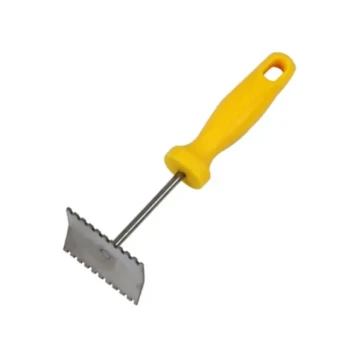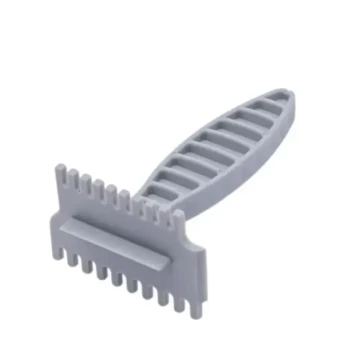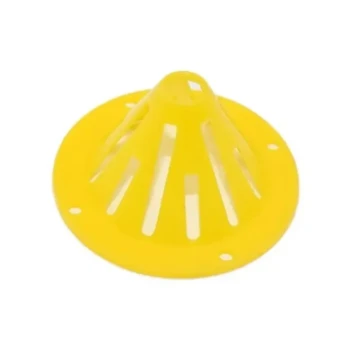At its core, grafting is a beekeeping technique for producing a large number of queen bees from a single, pre-selected mother hive. It involves the delicate manual transfer of a very young larva from its original worker cell into an artificial queen cell cup. This allows beekeepers to control the genetics and timing of queen production with precision.
The purpose of grafting is not just to create more queens, but to create better queens at scale. It transforms queen rearing from a reactive, natural process into a proactive, controlled method for propagating the most desirable genetics throughout an apiary.
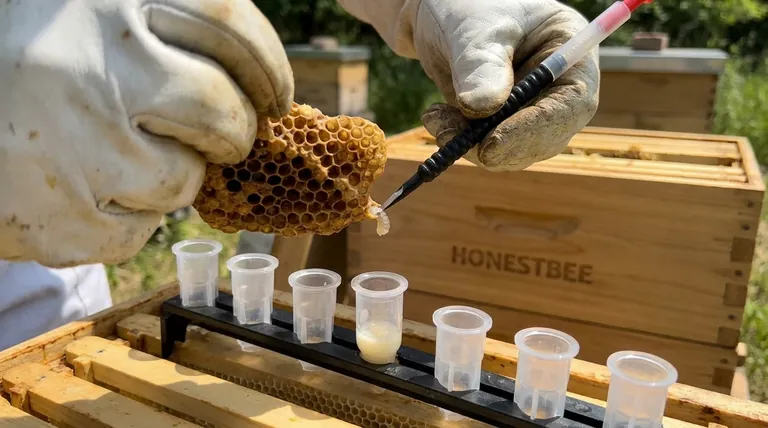
The Core Principle: Taking Control of Queen Creation
Grafting allows a beekeeper to intervene in the natural life cycle of the honey bee. It leverages the bees' own instincts to create queens on the beekeeper's terms, rather than waiting for the colony to decide on its own.
Selecting the "Breeder Queen"
The process begins by identifying the best-performing colony in the apiary. This "breeder queen" is chosen for specific, desirable traits such as high honey production, gentle temperament, or strong disease resistance.
The Manual Transfer
Using a specialized tool, the beekeeper carefully lifts a larva that is less than 24 hours old from a worker cell in the breeder queen's hive. This tiny larva is then placed into a plastic or wax queen cup.
Triggering the "Queen Switch"
These cups are then placed in a special, queenless "cell builder" colony. Because the larva is in a vertically oriented, cup-shaped cell, the nurse bees are instinctually triggered to feed it an exclusive, high-quantity diet of royal jelly. This special diet is the biological switch that ensures the larva develops into a queen rather than a worker bee.
Why Not Let the Bees Handle It?
While bees are perfectly capable of making their own queens, grafting provides critical advantages for the serious beekeeper. It replaces the uncertainty of natural queen production with a predictable and efficient system.
Genetic Consistency and Improvement
Grafting is the most effective way to propagate the superior genetics of a single queen. This allows a beekeeper to systematically improve the overall quality and performance of all the colonies in their operation.
Unmatched Scalability
Natural processes like swarming might produce one or two new queens. Grafting allows a beekeeper to produce dozens or even hundreds of queens from a single breeder queen in a single batch, on a predictable schedule.
Ease of Management
The resulting queen cells are uniform and housed in artificial cups. This makes them incredibly easy to handle, transport, and introduce into queenless hives or newly created nucleus colonies without disruption.
Understanding the Trade-offs
While powerful, grafting is a technique that requires precision and resources. It is not a casual undertaking and presents clear challenges compared to simpler methods of queen rearing.
It Is a High-Skill Technique
Successful grafting demands excellent eyesight, a steady hand, and significant practice. The larvae are incredibly fragile, and improper handling will result in their death and the failure of the graft.
It Requires Dedicated Resources
You cannot simply place grafted cells into any hive. Success depends on a very strong, well-fed, and densely populated "cell builder" colony that has been specially prepared to accept and care for the new queen cells.
Acceptance Is Not Guaranteed
Even with perfect technique, acceptance rates can vary. If the larvae are slightly too old, the environmental conditions are poor, or the cell builder colony is not in the right state, the bees will reject the grafts.
Making the Right Choice for Your Goal
Deciding whether to learn grafting depends entirely on the scale and ambition of your beekeeping.
- If your primary focus is commercial queen production: Grafting is the non-negotiable industry standard for producing queens efficiently and at scale.
- If your primary focus is expanding your apiary with high-quality genetics: This is the most direct method for making many new colonies that inherit the traits of your best hive.
- If your primary focus is self-sufficiency for a few hobby hives: Simpler methods, such as making a "walk-away split," are often more practical and require far less specialized skill and equipment.
Ultimately, grafting empowers beekeepers to move beyond simply managing bees and begin actively directing the genetic future of their apiaries.
Summary Table:
| Aspect | Benefit of Grafting |
|---|---|
| Genetic Control | Propagate desirable traits like high honey production and disease resistance. |
| Scalability | Produce dozens of queens from one breeder queen, unlike natural methods. |
| Management | Uniform queen cells are easy to handle, transport, and introduce to hives. |
| Skill Level | Requires precision and practice; best for serious or commercial beekeepers. |
Ready to take control of your queen production and improve your apiary's genetics?
As a commercial beekeeper or equipment distributor, you need reliable, high-quality supplies to succeed. HONESTBEE supplies the essential beekeeping supplies and equipment—from durable grafting tools to robust hive components—that commercial apiaries and distributors trust for their wholesale operations.
Let us help you build a more productive and resilient operation. Contact our team today to discuss your specific needs and explore our wholesale-focused product lines.
Visual Guide
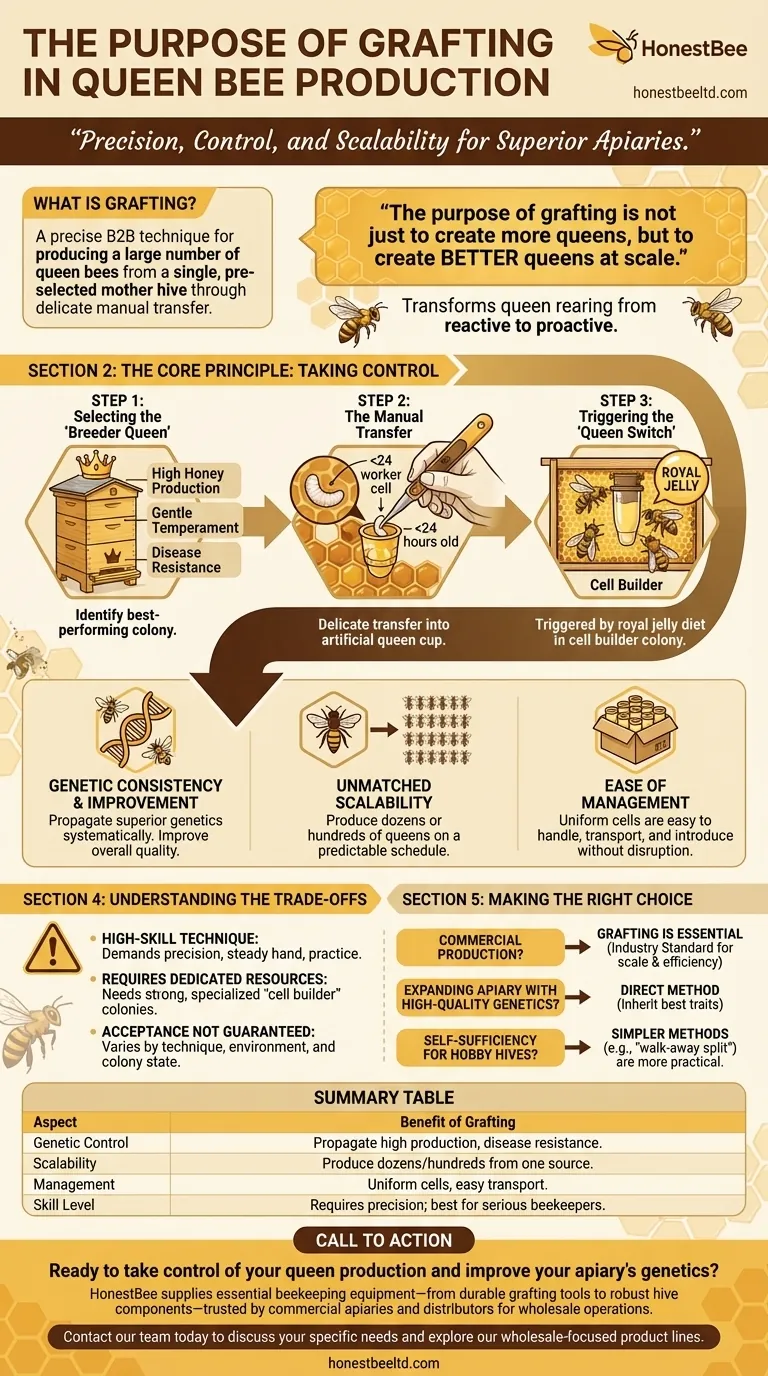
Related Products
- Black 2 Pack Beekeeper Queen Grafting Tool for Bee Queen Larva Transferring Needle
- Retractable Chinese Queen Rearing Grafting Tools Equipment
- Plastic Chinese Queen Grafting Tool for Bee Queen Rearing
- Electric Flatting and Embossing Machine with Tray for Beekeeping
- Stainless Steel Scraper for Metal Queen Bee Excluders
People Also Ask
- What is the grafting method of queen rearing? Master Controlled Queen Production for Your Apiary
- What happens if a larva is grafted too late? Avoid Scrub Queens and Failed Rearing
- How should the selected brood frame be prepared for grafting? A Step-by-Step Guide to Protect Larval Viability
- When do queens emerge after grafting? Master the 12-Day Critical Window
- What conditions should be avoided during grafting? Protect Your Queen Cells from Common Pitfalls




